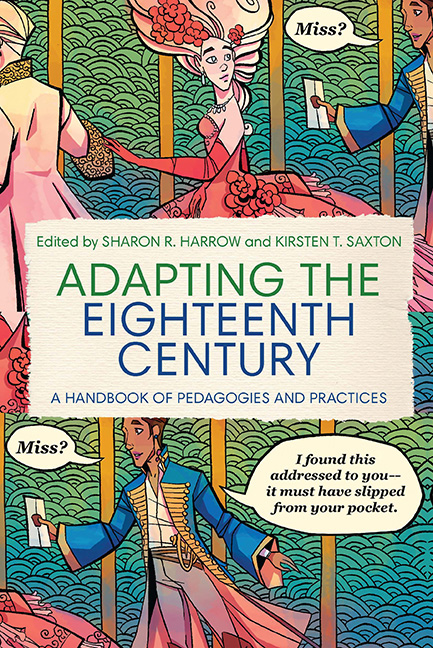Book contents
- Frontmatter
- Dedication
- Contents
- Acknowledgments
- Introduction
- 1 “Je suis Voltaire,” or, Appropriating the Philosophe in the Social Media Age
- 2 “Who Lives, Who Dies, Who Tells Your Story?”: The Uses of Hamilton in Special Collections Pedagogy and Public Engagement
- 3 Performing Frankenstein in the South: Sex, Race, and Science across the Disciplines
- 4 French Fairy Tales and Adaptations in the Twenty-First-Century Classroom
- 5 Select Trials at the Sessions-House in the Old-Bailey (1742) and Mark Ravenhill’s Mother Clap’s Molly House (2001)
- 6 Teaching with The Pilgrim’s Progress Video Game
- 7 Eliza Haywood’s “Bad Habits”: Teaching Adaptations of Fantomina: or, Love in a Maze and The Distress’d Orphan; or, Love in a Madhouse
- 8 Teaching Eighteenth-Century Literature through Eighteenth- Century Adaptations: Adaptive Structures
- 9 “A Private Had Been Flogged”: Adaptation and the “Invisible World” of Jane Austen
- 10 Fifty Shades of Pamela in the Undergraduate Classroom
- 11 Teaching the Austen-Monster-Mashup: Sense and Sensibility and Sea Monsters
- 12 Learning to Adapt: Teaching Pride and Prejudice and Its Adaptations in General Education Courses
- 13 Race and Romance: Adapting Free Women of Color in the Long Eighteenth Century
- 14 The Crusoeiana: Material Crusoe
- 15 Adaptation in Strange Places: Terrence Malick’s To the Wonder and the Narrative Effect and Form of Samuel Richardson’s Pamela
- 16 Adapting the Tombeaux des Princes: A Study in Media Variations
- 17 Experiential Pedagogy to Join the Thread of Conversation with Paul et Virginie
- 18 “Lookin’ for a Mind at Work”: Hamilton, Adaptation, and Enlightenment Ideals for the Core Curriculum
- Notes on the Contributors
- Index
Introduction
Published online by Cambridge University Press: 26 April 2020
- Frontmatter
- Dedication
- Contents
- Acknowledgments
- Introduction
- 1 “Je suis Voltaire,” or, Appropriating the Philosophe in the Social Media Age
- 2 “Who Lives, Who Dies, Who Tells Your Story?”: The Uses of Hamilton in Special Collections Pedagogy and Public Engagement
- 3 Performing Frankenstein in the South: Sex, Race, and Science across the Disciplines
- 4 French Fairy Tales and Adaptations in the Twenty-First-Century Classroom
- 5 Select Trials at the Sessions-House in the Old-Bailey (1742) and Mark Ravenhill’s Mother Clap’s Molly House (2001)
- 6 Teaching with The Pilgrim’s Progress Video Game
- 7 Eliza Haywood’s “Bad Habits”: Teaching Adaptations of Fantomina: or, Love in a Maze and The Distress’d Orphan; or, Love in a Madhouse
- 8 Teaching Eighteenth-Century Literature through Eighteenth- Century Adaptations: Adaptive Structures
- 9 “A Private Had Been Flogged”: Adaptation and the “Invisible World” of Jane Austen
- 10 Fifty Shades of Pamela in the Undergraduate Classroom
- 11 Teaching the Austen-Monster-Mashup: Sense and Sensibility and Sea Monsters
- 12 Learning to Adapt: Teaching Pride and Prejudice and Its Adaptations in General Education Courses
- 13 Race and Romance: Adapting Free Women of Color in the Long Eighteenth Century
- 14 The Crusoeiana: Material Crusoe
- 15 Adaptation in Strange Places: Terrence Malick’s To the Wonder and the Narrative Effect and Form of Samuel Richardson’s Pamela
- 16 Adapting the Tombeaux des Princes: A Study in Media Variations
- 17 Experiential Pedagogy to Join the Thread of Conversation with Paul et Virginie
- 18 “Lookin’ for a Mind at Work”: Hamilton, Adaptation, and Enlightenment Ideals for the Core Curriculum
- Notes on the Contributors
- Index
Summary
Adapting the Eighteenth Century: A Handbook of Pedagogies and Practices
This collection offers successful strategies for teaching eighteenth-century studies through adaptation. We are currently in what might be termed an age of adaptation, of remix culture and transmedial forms of narrative. The past few decades have seen the emergence of new kinds of adaptations across a slew of new digital genres, as well as adaptations across traditional generic platforms, and new versions of older analog DIY forms, such as handmade zines, clothing, individual art objects, and art books. The eigh- teenth century in England and France was also a “golden age of adapta- tion.” Classical epics were adapted to mock-epics, life writing adapted to novels, novels adapted to plays, unauthorized sequels abounded, and so forth. It is fitting, then, that the long eighteenth century is itself the subject of much current popular adaptation—eighteenth-century texts and culture appear in consumer products, comics, cult mashups, fan fiction, films, network and streaming shows, novels, theater stagings, and web seri- als. In adapting eighteenth-century texts, contemporary creators are work- ing in a particularly eighteenth-century mode.
Contemporary conceptions of prose narrative arise out of the long eigh- teenth century. It is difficult to think of a comparable historical period that has engendered as many adaptations. Daniel Defoe's Robinson Crusoe, Mary Shelley's Frankenstein, and Jane Austen's novels have been adapted so many times that they exist as clear cultural referents. Even when our students have not read the source texts, they apprehend the iconic role of the afterlives. Students also recognize the narrative structures and thematic points of eighteenth-century narratives with whose names or particulars they are entirely unfamiliar, such as John Bunyan's Pilgrim's Progress or Samuel Richardson's Pamela.
Westernnarratives—frompopculturetothelaw—arehauntedby eighteenth-century narratives, whose often unexamined histories provide crucial archives to our students’ contemporary imaginations, even if they are not aware of them. It is a critical commonplace that the material and sociocultural changes of the long eighteenth century shape our conception ofmodernityitself:scientificandtechnologicalinnovations,revolutions and resistance, the rise of capitalism, empire, the expansion and contrac- tion of rights, changes to the understanding of selfhood and the limits of the human, increased access to authorship and reading, tectonic changes in technologies of power and the business of everyday life, and the list goes on.
- Type
- Chapter
- Information
- Adapting the Eighteenth CenturyA Handbook of Pedagogies and Practices, pp. 1 - 23Publisher: Boydell & BrewerPrint publication year: 2020

